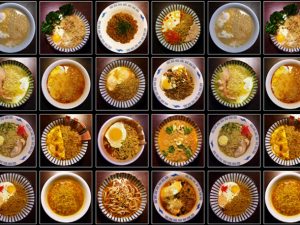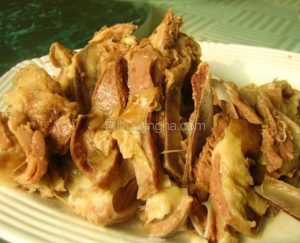Haopeng Xue
CHN 370W
Dr. Li
2019.8.9
Noodles are treated as one of the most important food sources to sustain ourselves to perform those daily activities. For the past 2000 years, noodle has evolved from wheat, wheat flour to Bing and Tang Bing and it also diverged into hundreds of different kinds with various cooking methods and combinations of ingredients. From noodles’ physical form, the appearance did not transform much, but it was repeatedly produced and redefined until nowadays. Chinese people of different ethnicities all regard noodles not only as an important food source, but also an auspicious dish for best wishes. Although traditional noodles seem simple and ordinary, it can be decorated and served as a main course on a dining table. Producing and processing the noodles is definitely a combination of arts and science based on local residents artistically skill and experiences with the dough. In my research paper, I will be discussing the embodiment of traditional cultural values of Chinese noodles that contributes to its attractiveness.
Reasons for attractiveness
There are thousands of stories and legends behind traditional Chinese noodles, which put pieces of mysterious veils on the noodles itself. During noodles’ evolution to perfections, the cultural exchange took place between China and Eastern Europe. Although the charm of Chinese noodle culture continues to spread, industrialization has taken place and erased the trace of traditional noodle making process. Even with large quantity of factory-made noodles, they lack essential nutrients and have varying level of quality. Producing noodles is one kind of science, requiring knowledge from an extensive field. Noodle makers not only need to know the history and stories behind each noodle, but also understand the cultural values. Noodles are parts of the “cultural encyclopedia” that is difficult to interpret, but it deserves to be cherished and is worth remembering.
The earliest type of noodle is called “Tang Bing” from Han dynasty. According to Shuxi’s Rhapsody on Pasta, he described the noodles “as tender as spring floss, as white as autumn silk. Steam, swirling and swelling, wafts upward.” This is one of the most important compliment s for noodles because it includes not only the appreciation for noodles’ shapes, but also the smell of the finished products. Chinese cuisines emphasize strongly on the color, the smell and the taste. The unique smells from noodles are based solely on wheat and mixed with several different side dishes to form a complete meal. In order to fulfill that requirement, Chinese noodles must choose the best and most fresh ingredients, the balance of the tenderness of the dough and skillful ways of cooking methods.
Choosing the right ingredients was the first requirement. Wheat flour, especially the whole wheat flour, must be fresh with the correct color, which has a brownish gold color. The quality of the noodles can decrease significantly if you use the flour that was chemically processed to make it look cleaner. The meat that is used for the sauce should come from naturally raised livestock in order to ensure its freshness and tenderness. The herbs for seasoning were classified based their functions on human bodies. Some were treated as to keep the body warm, while others can be used to cool the body down. Therefore, the combinations among these sides were determined by Yin and Yang of the food consumed by human body.
All these ingredients are a reflection of Yin-Yang of Chinese philosophy. The concept of yin and yang means that everything that existed in the universe has two opposing but complementary forces. Things that are determined to have much Yang energy tend to be warm and bright, while yin energy is said to be cool and dark (Guo 94). Traditional Chinese medicine established that a deficiency or excess of yin or yang will disturb the internal balance of the body, which causes sickness for people, leading to bodily and spiritual ailments. As such, it is crucial to maintain a balanced diet and consume the right food at the right time of the year.
Different ingredients also work together to achieve a balance in flavor (sour, sweet, bitter and spicy). A responsible chef will organize the meat, vegetables and starch (rice or noodles) with a proper proportion, which not only balance the nutritional need for yin and yang energy, but also fulfills the standards for color, smell and taste of the dish. According to a legend, during Sixteen Kingdoms period, one of the emperors, Yao Hong, ordered the chef to select particular ingredients from different regions to make Tang Bing since the quality of food sources and the yin-yang energy can vary depending on the regions. The wheat must come from An Ding county in Gan Su province; the green anions are selected from An Yang county in He Nan province; the beef is collected from Inner Mongolia; the chili pepper is also from Cheng county, Gan Su province. This recipe is a perfect demonstration of a harmonic diet by presenting the beef and pepper as yang and wheat and green onions as yin. With the advancement of technology, it is much more convenient to gather all the ingredients and make the traditional noodles starting from scratch.
The second requirement is the tenderness and smoothness of the dough. The ratio between water and flour that are mixed together has to be precise in order to make the dough neither too hard nor too soft. Afterwards, the person who is kneading the dough need to exert his force evenly to squeeze out the air and flatten the flour sheet with the same thickness. The last step is cutting the noodles from the flour sheet. This task takes years of practice because every strand of noodles must be equal in width, and depending on the types of noodles, the width can also vary. People can also use the dough to make hand pulled noodles, which is another indication of harmony. To pull the dough into noodles of different thickness, a chef needs to have extraordinary strong arms and also exquisite skills in controlling his strength. It takes strength to pull two pieces of dough away from each other, but if you pull too hard, the noodles will break from the middle. Therefore, maintaining the balance of strength is crucial in the noodle making process, which is a reflection of philosophical Chinese cultures.
The last requirement is ingenious cooking method. Balancing of the five tastes is the core of cooking Chinese food. By processing different ingredients under different temperatures to best capture its natural smell and taste, Chinese noodles retain the essence of food itself. The key to make the best noodles is by making sure that all the flavors from the spices can be stimulated and exploited to the max. Controlling the temperature of the vegetable oil and the time of stirring the scallions, gingers and garlics are two most important tasks for the chef. The chemical reaction that took place within the pot determines the quality of the noodles. An experienced Chinese chef will know exactly what the order is to add the ingredients and how long and how hot should the pot stay on. In addition, different cooking methods also have yin and yang associations. Frying the noodles is considered as yang, whereas boiling the noodles is yin. These characteristics shaped Chinese noodles’ complexity and contributed to its attractiveness for those who were just exposed to this noodle world.
Stories behind each Noodles
- Long Life Noodles
Noodles becomes more than just a food to keep people away from starvation, but also a carrier of traditional cultural values. Longevity is one of the revered concepts based on ancient Chinese culture, along with fortune and happiness. In the past, noodles were consumed to pray for longer life span due to its shape as long and thin strands. Younger generations should prepare a bowl of longevity noodles for their parents at their birthday. Based on traditional virtues of Chinese nation, respecting one’s parents is regarded as one of the most important values. According to the class reading “Long Life Noodle Recipe”, when people turn fifty, sixty or even one hundred years old, longevity noodles will always be served at the end for its auspicious meaning of longevity. Longevity noodles originated from one of the Emperors of Han dynasty, Liu Che. One day, he was discussing with his ministers about each person’s life span, since it is considered as the ultimate blessing if a person can live longer. One of the ministers proposed that if the space between a person’s nose and upper lip is one centimeter long, then that person can live to one hundred years old. Everyone starts to laugh at his idea since it seemed silly to associate long face with long life. However, there is other ore flexible way to express the auspicious meaning for longevity. Therefore, his prime minister stepped up and explained, “the longer one’s face is, the longer the noodles should be(脸长就是面长)”, which only make sense in Chines phonetically. Both “lian” and “mian” means face, and “mian” also stands for noodles. In this way, people can yse long noodles as a blessing for longer life (Kim 111).
Later, when people begin to make long life noodles, the kneading process will make a thin layer of flour sheet and the connotation of that is “Shou” (瘦), which is equivalent to the pronunciation of longevity in Chinese. The popularity of long-life noodles increased quickly since even the poor family is able to prepare the noodles and soup in order to pass on and spread this tradition. In addition to noodles’ function as blessing, it is also an indicator of Chinese traditional values for respecting your parents. Children try to demonstrate love and respect for their parents through the use of long-life noodles to share their blessing to their parents every year after they turned fifty years old. Later on, when they are gradually aging, the next generation of kids can continuously to pass on this tradition as a reminder of its philosophical value.
- San Fu Mian
San Fu is the hottest time of the year. From ancient times till now, it is Chinese people’s tradition to have noodles at this day. In the past, at the first day of summer, people would hold sacrificial ceremony to pray for rainfall. As the flour that is produced within that year just entered the market, they would offer the flour to God. Another explanation is that the first day of summer is the longest day with sunlight, and peasants want the day-time to become shorter. By consuming the noodles, it feels as if people are shortening the day (Yu 112). When the first day of winter comes, they will eat dumplings instead to remind them of the day-time that will turn longer again (Kim 136). There are usually two kinds of noodles that were consumed: a bowl of hot noodles with soup or simply cold noodles. During those hot days, it is highly likely that one will lose his appetite, become easily irritated and catch some disease. If people consume warm noodles and drink the soup when the weather is hot, they will sweat quickly, which increases their metabolism and dampness within their body. Drinking the hot soup could also increase one’s memory and cognitive ability, which is scientifically proven. The noodle soup contains large amount of lecithin, which constitutes the somatic cell membranes and nervous system. Drinking noodle soups gives brain time to improve its cognitive ability the body’s vitality. The second way is rinsing the noodles with cold water and mix it with vinegar, garlic, mustard and sesame sauce. The refreshment from vinegar can increase appetite and the spiciness from the garlic can kill some of the germs in one’s mouth. This idea reflects the fact that Chinese people used to treat food as medicine, and by incorporate a variety of cooking methods, there can be different benefits for our health depending on the ingredients and the chef’s decisions. San Fu Mian showed not only the wisdom of our ancestors by marking the time of the day-light with food, but also showed their exploration over the medical use of food.
Conclusion
After five thousand years of cultural accumulation, Chinese noodles has absorbed the knowledge and traditions that are passed down through generations. The noodles itself transformed from a lifeless starch-based food source into a dish with its own soul and values. Through the research that I conducted, it is evident that Chinese noodles demonstrates its attractiveness to the world not only because of its taste and smell, but also its function as “cultural encyclopedia” of the Chinese society.
Works Cited
Guo, Bisong, and Andrew Powell. Listen to Your Body: The Wisdom of the Dao. University of Hawai’i Press, 2002. JSTOR, www.jstor.org/stable/j.ctt6wqqmn.
Kim, Kwang Ok, editor. Re-Orienting Cuisine: East Asian Foodways in the Twenty-First Century. 1st ed., Berghahn Books, 2015. JSTOR, www.jstor.org/stable/j.ctt9qcwzq.
Yü, Ying-shih. Chinese History and Culture: Sixth Century B.C.E. to Seventeenth Century. Edited by Josephine Chiu-Duke and Michael S. Duke, Columbia University Press, 2016. JSTOR, www.jstor.org/stable/10.7312/yu–17858.


 ure of hand grilled lamb.
ure of hand grilled lamb.